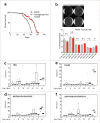Keeping it tight: The relationship between bacterial dysbiosis, septate junctions, and the intestinal barrier in Drosophila
- PMID: 29455581
- PMCID: PMC5927685
- DOI: 10.1080/19336934.2018.1441651
Keeping it tight: The relationship between bacterial dysbiosis, septate junctions, and the intestinal barrier in Drosophila
Abstract
Maladaptive changes in the intestinal flora, typically referred to as bacterial dysbiosis, have been linked to intestinal aging phenotypes, including an increase in intestinal stem cell (ISC) proliferation, activation of inflammatory pathways, and increased intestinal permeability1,2. However, the causal relationships between these phenotypes are only beginning to be unravelled. We recently characterized the age-related changes that occur to septate junctions (SJ) between adjacent, absorptive enterocytes (EC) in the fly intestine. Changes could be observed in the overall level of SJ proteins, as well as the localization of a subset of SJ proteins. Such age-related changes were particularly noticeable at tricellular junctions (TCJ)3. Acute loss of the Drosophila TCJ protein Gliotactin (Gli) in ECs led to rapid activation of stress signalling in stem cells and an increase in ISC proliferation, even under axenic conditions; a gradual disruption of the intestinal barrier was also observed. The uncoupling of changes in bacteria from alterations in ISC behaviour and loss of barrier integrity has allowed us to begin to explore the interrelationship of these intestinal aging phenotypes in more detail and has shed light on the importance of the proteins that contribute to maintenance of the intestinal barrier.
Keywords: Bacterial dysbiosis; Gliotactin; Intestinal barrier; Intestinal stem cells; Septate junctions; Tricellular junctions.
Figures


Similar articles
-
Tricellular junctions regulate intestinal stem cell behaviour to maintain homeostasis.Nat Cell Biol. 2017 Jan;19(1):52-59. doi: 10.1038/ncb3454. Epub 2016 Dec 19. Nat Cell Biol. 2017. PMID: 27992405 Free PMC article.
-
Interplay between Anakonda, Gliotactin, and M6 for Tricellular Junction Assembly and Anchoring of Septate Junctions in Drosophila Epithelium.Curr Biol. 2020 Nov 2;30(21):4245-4253.e4. doi: 10.1016/j.cub.2020.07.090. Epub 2020 Aug 27. Curr Biol. 2020. PMID: 32857971
-
Gliotactin, a novel marker of tricellular junctions, is necessary for septate junction development in Drosophila.J Cell Biol. 2003 Jun 9;161(5):991-1000. doi: 10.1083/jcb.200303192. Epub 2003 Jun 2. J Cell Biol. 2003. PMID: 12782681 Free PMC article.
-
The Drosophila septate junctions beyond barrier function: Review of the literature, prediction of human orthologs of the SJ-related proteins and identification of protein domain families.Acta Physiol (Oxf). 2021 Jan;231(1):e13527. doi: 10.1111/apha.13527. Epub 2020 Aug 5. Acta Physiol (Oxf). 2021. PMID: 32603029 Review.
-
Enteric Pathogens and Their Toxin-Induced Disruption of the Intestinal Barrier through Alteration of Tight Junctions in Chickens.Toxins (Basel). 2017 Feb 10;9(2):60. doi: 10.3390/toxins9020060. Toxins (Basel). 2017. PMID: 28208612 Free PMC article. Review.
Cited by
-
Compromised junctional integrity phenocopies age-dependent renal dysfunction in Drosophila Snakeskin mutants.J Cell Sci. 2023 Oct 1;136(19):jcs261118. doi: 10.1242/jcs.261118. Epub 2023 Oct 5. J Cell Sci. 2023. PMID: 37694602 Free PMC article.
-
The Snakeskin-Mesh Complex of Smooth Septate Junction Restricts Yorkie to Regulate Intestinal Homeostasis in Drosophila.Stem Cell Reports. 2020 May 12;14(5):828-844. doi: 10.1016/j.stemcr.2020.03.021. Epub 2020 Apr 23. Stem Cell Reports. 2020. PMID: 32330445 Free PMC article.
-
Intestinal Snakeskin Limits Microbial Dysbiosis during Aging and Promotes Longevity.iScience. 2018 Nov 30;9:229-243. doi: 10.1016/j.isci.2018.10.022. Epub 2018 Oct 24. iScience. 2018. PMID: 30419503 Free PMC article.
-
Gut microbiome-mediated mechanisms in aging-related diseases: are probiotics ready for prime time?Front Pharmacol. 2023 Jun 1;14:1178596. doi: 10.3389/fphar.2023.1178596. eCollection 2023. Front Pharmacol. 2023. PMID: 37324466 Free PMC article. Review.
-
Ageing, metabolism and the intestine.EMBO Rep. 2020 Jul 3;21(7):e50047. doi: 10.15252/embr.202050047. Epub 2020 Jun 21. EMBO Rep. 2020. PMID: 32567155 Free PMC article. Review.
References
Publication types
MeSH terms
Grants and funding
LinkOut - more resources
Full Text Sources
Other Literature Sources
Molecular Biology Databases
